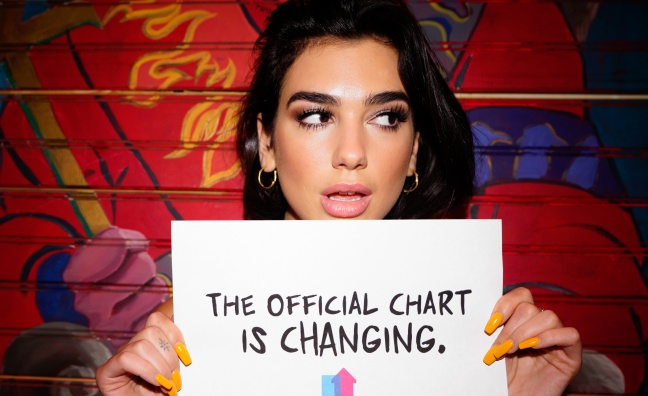Music Week caused a sensation this week when it broke the news of big changes coming to the Official Singles Chart.
Hot on the heels of the last revamp, when the Official Charts Company introduced a three-track cap on songs by the same lead artist and introduced increased sales:streams rates for records in long-term decline, this time around, the OCC has added video downloads and streams to the chart for the first time, and introduced different streaming rates for ad-funded and premium streams (1:600 and 1:100 respectively).
The changes are aimed at helping more new music break through and at speeding up the chart – and the OCC’s track record is strong, with Music Week research at the end of last year showing that the 2017 changes resulted in more hits at every level.
But what will the latest changes mean for the biz, and how will they be applied? With the changes kicking in today (June 29) for next week’s chart (published July 6), Music Week quizzed Official Charts Company chief executive Martin Talbot and non-executive chairman Derek Allen (also SVP, commercial with Warner Music UK) to get answers to every possible question. So check out our guide to the new rules (and count ‘em)…
Why is the chart changing again?
Video was included in the US chart some time ago and the move has been expected here for some time. The key catalyst for UK inclusion seems to have been the addition of video at Spotify, Apple Music and Tidal, although YouTube’s move into subscription services probably helped too. Many in the biz have been calling for premium streams to be upgraded for a long time, given the greater revenue for rights-holders. It’s also considered by many to be a more elective choice by consumers, meaning it’s closer to the chart’s traditional reliance on sales.
Which sites will be contributing video sales/streams?
YouTube, Apple, Spotify and Tidal. No Facebook or Instagram (which has recently increased the length of videos allowed on the service) for now. Vevo branded content on YouTube will count, but not views on Vevo’s soon-to-be-shuttered own platforms.
Will free video views count for the same as subscription ones?
No, they’ll be counted at the same new rates as free audio streams eg 1:600. Premium streams will count at 1:100.
How long does a video have to be watched for to count for the chart?
Just 30 seconds.
Which types of videos will count for the chart?
“Anything officially sanctioned by the artist or rights-holders”, according to Talbot. The audio and video ISRC codes must match. Lyric videos will count. User Generated Content won’t. “If somebody posts their wedding dance to Ed Sheeran’s Shape Of You that won’t count,” said Talbot.
What difference will the inclusion of video make to the chart?
Talbot and Allen say the OCC has tracked the impact for a year and it has minimal impact for most tracks. Even the inclusion of Childish Gambino’s viral video for This Is America would have only bumped it up a few places, apparently. Most hit videos are also hits at audio streaming. But there is a significant difference between the most-streamed videos of 2017 and the biggest singles.
Won’t the inclusion of video favour major labels with big budgets?
Again, OCC research suggests not. Allen says the impact will be “commensurate” with the general performance of the two sectors.
Why has the change to streaming ratios taken so long?
Germany, France, Spain and Italy have all stopped counting free streams at all in recent months. The US is downgrading them too. With the biz focused on subscription, and streaming now regularly accounting for 95% of the singles market, the OCC decided the time was right.
Why are the rates for ad-funded and premium streams so far apart?
According to the OCC, the new rates were decided after a BPI royalty review aimed at equating the value of the relative streams.
Did everyone agree on the new rates?
They were signed off by all parties. Music Week sources suggest some DSPs with free tiers weren’t too thrilled at being downgraded to this extent, while some rights-holders thought the changes didn’t go far enough. The OCC rates aim to meet somewhere in the middle.
What happens to the streaming rates when the criteria for accelerated decline are met?
The same as for the current rate. When the criteria are met, the sales:stream rate doubles, so 1:200 for premium streams and 1:1200 for free ones.
What impact are the new rates likely to have on the chart?
Again, OCC research suggests the impact on chart position should be minimal. After all, a hit on premium services is usually a hit on free ones too. Research suggests premium streams are more ‘leaned in’, which may help new records enter higher and old records exit faster. But while you’d assume younger consumers are more likely to use free services, there’s no sign that any genre will be disproportionately affected.
Is the album chart affected by any of the changes?
No. Album streams are calculated on the SEA2 measurement so the new ratios don’t apply. The OCC doesn’t rule out adding a video element if Beyoncé’s penchant for ‘visual albums’ catches on, but don’t expect single videos to be counted any time soon.
Could further changes be in the pipeline?
The OCC says potential changes are constantly under review. Sections of the biz have previously called for playlist streams to be downgraded or for radio play to be added, and the charts body isn’t ruling anything out. “It’s no secret those things do come up,” said Allen. “There’s a number of changes we’re looking at in terms of the way the market’s developing and whether the chart should reflect those elements.” Watch this space…
To read the full story of the OCC changes, see this week’s print edition of Music Week or click here. To subscribe and never miss a vital music biz story, click here.










